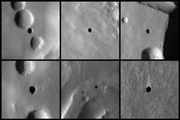LONG BEACH, California -- The public will have to overcome its squeamishness about nuclear power, if current plans for space missions and manned outposts are ever to become reality, industry experts told attendees at the Space 2007 conference this week.
The public's fear of fallout and the government's worries about losing nuclear material have led to onerous requirements in using radioactive sources of power for space probes and to funding cuts for nuclear propulsion research, executives said. Future missions and the creation of outposts on the moon and other planets will require the technology, they added.

|
| ©NASA / William K. Hartmann
|
| Proponents argue that nuclear propulsion could allow space probes, such as the Dawn mission to the asteroid belt, to reach their destinations faster and do more once they get there.
|

Comment: For more on this catastrophe, see the article Forget About Global Warming: We're One Step From Extinction!
The recent crater in Peru may well be the first of many impacts we'll be seeing over the next few years. We may be on our way to going the way of the wooly mammoth.